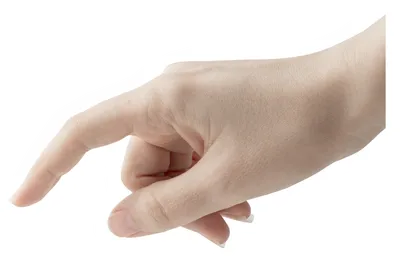want some cookies?
We use cookies to make your browsing experience amazing.

To effectively market your learning offering, you have to have a really deep understanding of what your product really is. But most L&D teams don’t have a defined product, and this eBook is designed to help you change that. Using a few nifty marketing tools, we’re gonna help you define your L&D product, and get you prepped for fantastic marketing. #YoureWelcome.
WHAT IS AN L&D PRODUCT?
If you have a learning offering, you have an L&D product. Fact.
Your L&D product might be face-to-face training, a blended intervention, a learning library – or all of the above and much more. Simply put: your product is everything you offer to your audience.
So surely this guide finishes here? We’ve defined what an L&D product is. Job done. *Dusts off hands*
Of course not – defining your L&D product is much more than that. And it’s actually the cornerstone of effective marketing, for 5 key reasons. Product definition allows us to:
- Articulate benefits clearly. If you don’t know what problem or challenge your product solves, how on earth can you communicate the benefits with your audience?
- Answer the WIIFM. The ‘WIIFM’ (What’s in it for me?) is something we talk about a lot at MAAS. What will your audience get out of getting involved with your learning offering?
- Bat away competition. You might think you don’t have competition as an internal L&D department, but you do (e..g. Netflix, their Phones, their children…) By defining your L&D product, you can bat away competition much easier! (Although we would not recommend literally batting away children... obvs.)
- Manage L&D resources more effectively. It’s not all about marketing around here. Knowing your L&D product – and perhaps even your product road map – will help you manage resources & capacity much more efficiently.
- Boost engagement – and isn’t that what we all want?
Product definition should steer every element of your marketing strategy. And without a clearly defined L&D product, you’ll struggle to get your people to consume your learning time and time again.
Talking of consuming…
ARE THEY LEARNERS OR ARE THEY CONSUMERS?
"There are no learners because there are no ‘breathers’ – that is to say we all learn and breathe, but we don’t talk about people as ‘breathers’ and we shouldn’t talk about people as ‘learners’ for the same reason." – Nick Shackleton-Jones, CEO and Founder, Shackleton Consulting.
Here at MAAS, we take umbrage with the phrase ‘learner’. But annoyingly it’s so well accepted in the world of L&D that we can’t seem to avoid it. The issue with the word ‘learner’ is that you’re immediately putting the onus on the individual to learn. It’s an active word and it infers that they are already learning. But we all know that isn’t the case. In fact, more often than not, our people don’t even want to learn.
So, instead of thinking about your audience as ‘learners’, we challenge you to think of them as consumers. This immediately injects choice into the equation – doesn’t it? Your consumers can choose whether they use your product, or not. And you absolutely cannot force them to do it.
If you think about forcing someone to consume something, you probably have weird images of food being shoved down someone’s throat spring to mind. (And if you didn’t, I’m sorry, because I’m sure you do now!) But that’s what we do all too often in L&D. We shove our learning down the throats of our target audience – immediately setting the wrong precedent about learning.
Instead, if we think of them as consumers, with a choice about whether they want to take part in our learning or not, we’ll change our narrative. Heck, we might even decide to start marketing our learning offering! (Crazy, right?!) And we’ll definitely make sure our product is defined in such a way that our audience wants to engage with us, and that our product matches their expectations. It’s for this reason that the value proposition canvas is a marketers best friend…
PRODUCT POSITIONING
Defining your L&D product is about marrying up your offering to your target audience’s wants and needs – and highlighting how it’ll help them alleviate some of their fears and pain points. And the value proposition canvas (VPC) helps us do this much more easily.
A completed VPC enables you to craft more impactful marketing messages, that relate to both the benefits of your product AND your auidences desires. Hey, it might even help you refine your product or realise a gap in your offering.
AND IT LOOKS A LIL’ LIKE THIS:
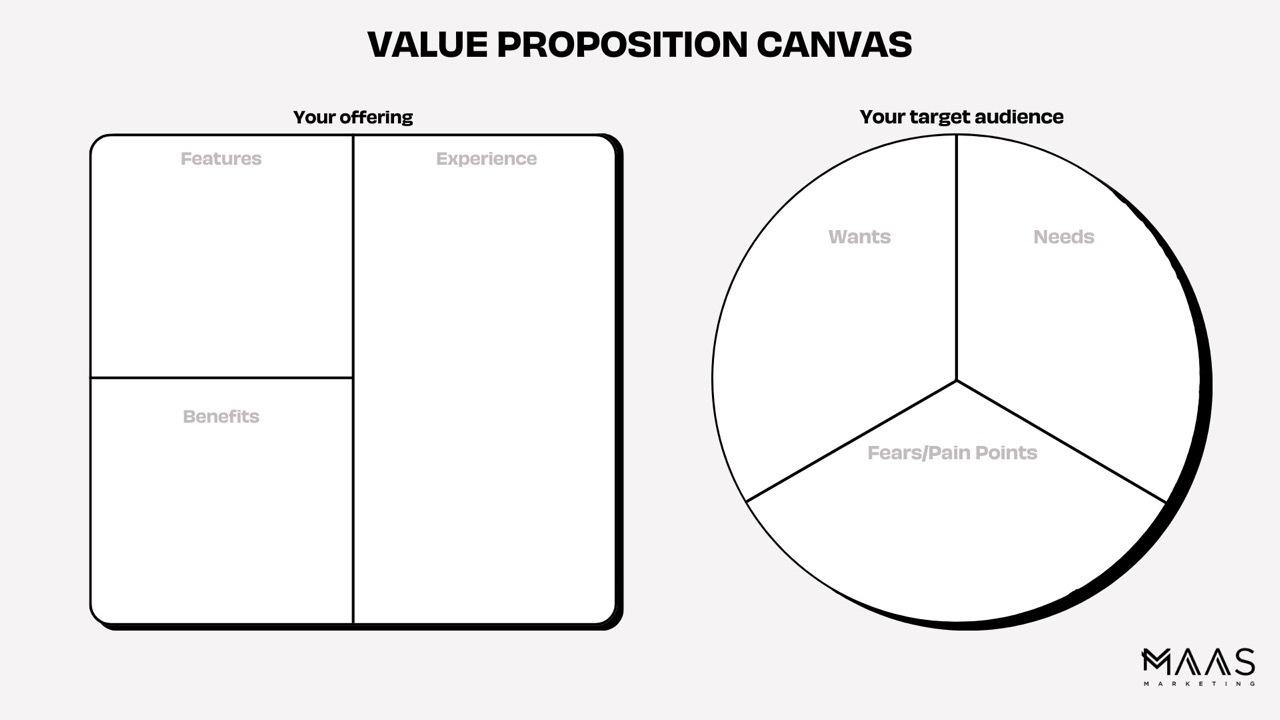
The VPC is made up of two halves, with three sections each. So let’s look at them in more detail...
YOUR PRODUCT
The product side of your VPC is made up of 3 sections:
FEATURES
Although you should never market your L&D product based on its features, you must understand them. Because our product features help us to determine the benefits of getting involved.But when you’re filling out your ‘features’ box, make sure you’re considering your entire learning offering. It’s really easy to just think of your LMS or LXP here. But what about your face-to-face programmes? Training days? PDFs? Learning in the flow of work? Make sure you include features of your entire offering!
BENEFITS
What is it about your product that is going to positively impact somebody? How is it going to help them achieve their goals? Is it going to make them more productive? Is it going to help them climb the career ladder? Does it save them time? Does it equip them to prioritise themselves? The benefits of your product add the human element to your offering. Looking at an example away from the world of learning, a feature of Apple devices is that they sync up with one another (i.e. your MacBook links with your iPhone and iPad). That’s a feature. The benefit to this is that you have seamless access to your photos, your contacts, your notes, and anything else that's on your iCloud account, no matter which device you have with you. #Simples
EXPERIENCE
What’s the experience like when people get involved with your learning offering? Is it inclusive? Is it the best quality curated content? Is it welcoming? Is it fun? Ultimately the experience box is answering: how does our product or service make our target audience feel?
Oftentimes the experience you anticipate your audience will have, and the reality of the experience, are vastly different. So we’d recommend talking to people about their lived experiences to help you fill out this box.
YOUR AUDIENCE
The audience side of your VPC might feel very familiar if you’ve done a lot of persona work! But spend the time highlighting the wants, needs and fears of your target audience here. These three areas are some of the biggest behavioural drivers, and will paint a clear picture of why your audience are acting in a certain way; and what will help them change!
WANTS
What does your audience want to make their life easier? What is it that will make them happy? Is it a pay rise? Is it to help others grow? To provide a better service for their clients? Ultimately... what is it that gets them out of bed in the morning?
It’s really tempting here to list out learning wants: e.g. they want bite sized content, they want certifications etc. etc. But doing so is falling into the trap of them just being a ‘learner’. Your audience's wants are much bigger than learning – and often rather than a want in itself, learning is the solution to help them get what they actually want.
NEEDS
Unlike wants, needs are non-negotiable. Career growth is often a need related to L&D audiences – and it’s clear to see how learning is the answer to that. Relevant learning opportunities also come up time and time again. But how about psychological safety? Empathy? Time? Permission? There’s a lot that your audience might need before they can interact with your offering – and you must do the work to understand these!
FEARS & PAIN POINTS
Now this section often makes L&Ders uncomfortable. Because fears are a bit awkward aren’t they? We don’t want to acknowledge that our audience might be worried about something. Or that something is causing them pain. But it’s really important that we do.
This box unlocks a whole world of marketing tactics and approaches for you. And although we don’t want to evoke behaviour or action from a place of terrified panic (i.e. we’d never say ‘do this or you’ll lose your job!’) Feelings associated with fear promote action, for example: the growing skills gap. That is a fear-based message, but it doesn't mean that you're trying to terrify everybody with your comms.
Completing a VPC will help you gain a holistic understanding of your product and audience – and how the two match (or not!) And somewhere between the two of these is where we cook up our marketing magic and create an L&D product that our people actually want to engage with.
CRAFTING A BRAND NARRATIVE
So now we’ve got our completed VPC, we need to create something a lil’ more tangible, right? That’s where our brand promise & positioning statement step in.
Your brand promise is a pledge you are making to your target audience about what you will deliver to them. What kind of experience can they expect when interacting with you? What standard are you going to hold yourself to? Now is the time to stop thinking of yourself as “the L&D team”. Instead, consider yourself a collective that is on a mission to fulfil your brand promise.
Brand promises aren't necessarily something that you'll ever see in external marketing., because they’re super personal and often internal. But I’ve done some digging and found a brand promise example for you:
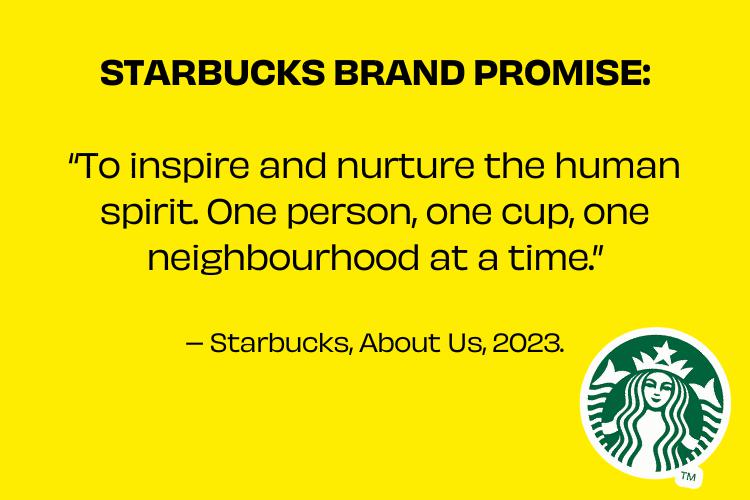
But wait… they didn’t mention coffee at all?! Yep.
That’s right – you don’t need to overtly mention your product in your brand promise. Your brand promise is your “why”. Why are you doing what you’re doing? What keeps you going? What gets you out of bed every morning?
Despite not mentioning coffee, Starbucks' brand promise isn’t a surprise is it? Their brand promise exudes in all they do. In their adverts. In their staff. In their stores. Even the way they write names on their cups. It’s very personal, and you can see how they’re trying to nurture the human spirit, right? Starbucks’ brand promise is a pledge, it’s the one thing they consistently deliver on. So why is a brand promise important for L&D? Well sticking to your brand promise builds trust with your audience – and if your audience doesn't trust you, they’re not going to get involved with your learning offering, are they?
CREATE A BRAND PROMISE IN 3 STEPS:
- Analyse your value proposition canvas.
Use your VPC to identify what your audience wants from you, and what they’ll get from getting involved with your learning offering. Answer the all important “what’s in it for me?” question. - Carefully consider your offering.
You probably have an LMS, LXP, or something similar. What's the experience of that like? If you are promising your people that they are going to get the best learning experience of their life, but your LMS is absolutely pants. There's gonna be a bit of an imbalance, right?! So this step is about looking at your offering – and being real with yourself. - Keep it simple and make it catchy!
Make sure your brand promise is something your entire team can remember. Make sure it's something that's catchy, that keeps people on path, that keeps people working towards those set values that you have as a learning team.
The truth is, brand promises are a really simple part of a really big process (defining your product). And after creating your brand promise, you aren’t finished. You need to think about your product positioning if you want to make real impact...
WHAT IS A POSITIONING STATEMENT?
So, what is a positioning statement? Well, HubSpot can answer that better than I can, so…
“A positioning statement is a brief description of a product or service and an explanation of how it fulfils a particular need of the target market. The goal of a positioning statement is to align marketing efforts with a company's brand and value proposition." – HubSpot, 2023
So simply put: a positioning statement combines your brand promise and your VPC – and identifies how your product meets your audience’s needs, AND how it aligns with your business goals. Let’s look at an example of a positioning statement:
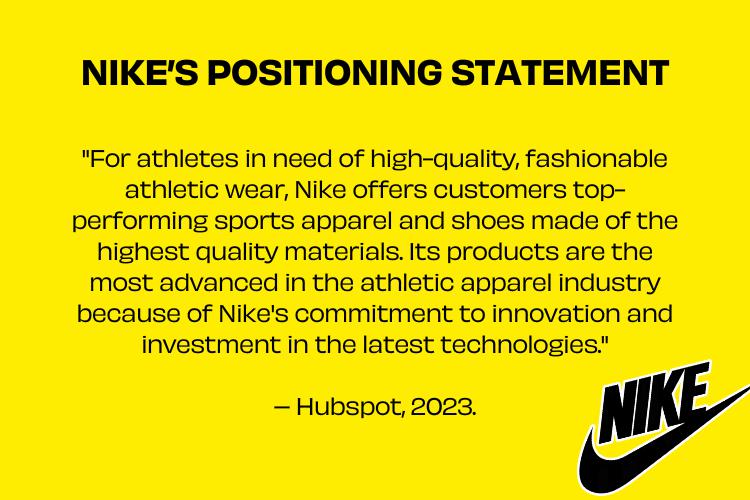
Nike’s positioning statement is clear, impactful and to the point. It considers the how, what and why of their offering. And it’s for this reason that positioning statements are so important in L&D. So let’s look at creating one, shall we?
CREATING YOUR L&D POSITIONING STATEMENT
HubSpot have created a template for creating positioning statements – giving us a great place to start:
For [your target audience] who [target market need], [your brand/product name] provides [main benefit that differentiates your offering] because [reason why target audience should believe in your differentiation statement].
So we have 4 key questions to answer:
- Who is our target audience?
- What are their needs?
- What is the main benefit of our learning offering?
- Why should our audience believe us?
The first three questions are answered in your VPC, so we actually only need to create one piece of our positioning statement, and then piece it all together. #Winning
But it’s that final part that most L&Ders struggle with. For decades L&D have lived in a bubble where we believe people should believe us and use our content – because we said so. But our audiences have wised up to this. And they won’t take “because we said so” any more.
It’s time to really think about why your audience should believe you and get involved with our learning offering. We can’t tell you the answer to that right now (not without doing some deep discovery work with your team), so for now, this is a point of self-reflection... but reviewing your VPC will help!
Okay, so let’s put HubSpot’s template to work and dissect Nike’s positioning statement:
- TARGET AUDIENCE: Athletes
- AUDIENCE'S NEEDS: High-quality, fashionable athletic wear
- MAIN BENEFIT: Top-performing sports apparel and shoes made of the highest quality materials
- WHY SHOULD THEY BELIEVE YOU? Because of Nike's commitment to innovation and investment in the latest technologies.
We can see how that works. But in L&D we often haven’t got a lot of time and money to invest in the latest tech or innovation, do we? So that doesn’t help us with the ‘why?’ Let’s look at another example…
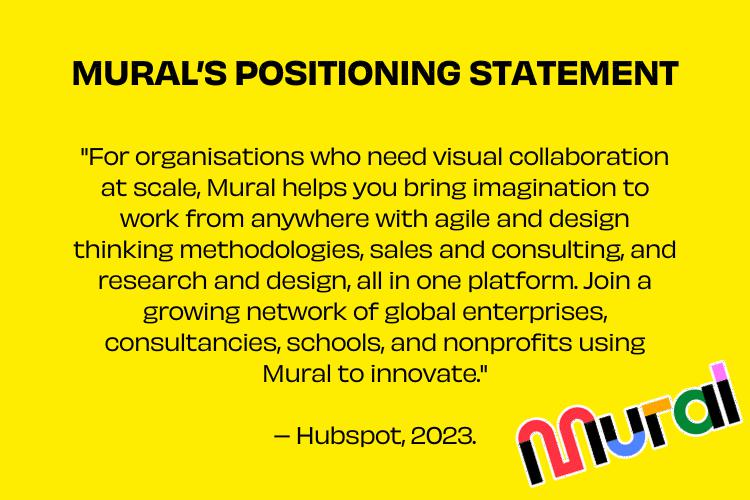
Now let’s break this down into HubSpot’s template…
- TARGET AUDIENCE: Organisations
- AUDIENCE'S NEEDS: Who need visual collaboration at scale
- MAIN BENEFIT: Imagination to work from anywhere with agile and design thinking methodologies, sales and consulting, and research and design, all in one platform.
- WHY SHOULD THEY BELIEVE YOU? Growing network of global enterprises, consultancies, schools, and nonprofits using Mural to innovate.
Okay, that’s social proof and a firm reason why their audience should believe. But not all L&D teams have a growing network of learners, so let’s look at a hypothetical example for L&D…
EXAMPLE L&D POSITIONING STATEMENT
We don’t have an L&D team here at MAAS. But if we did, a first draft of our L&D positioning statement might look a lil’ like this:
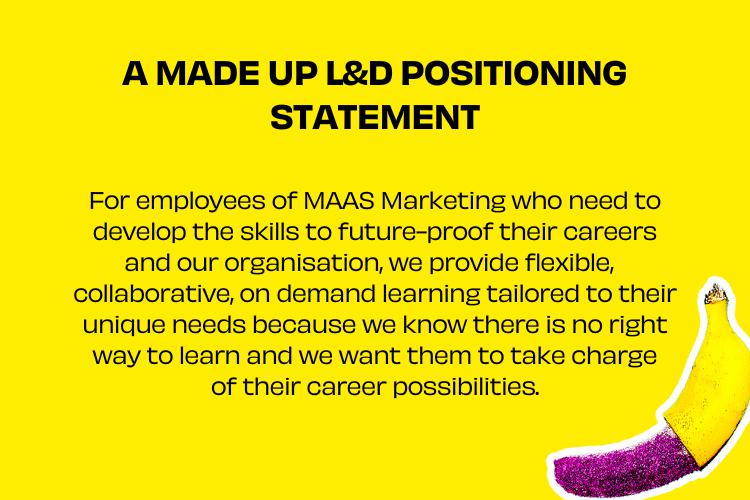
Let’s distill this down into our template, to check we’re hitting all the right marks!
- TARGET AUDIENCE: Employees of MAAS Marketing
- AUDIENCE'S NEEDS: Who need to develop the skills to future-proof their careers and our organisation
- MAIN BENEFIT: We provide flexible, collaborative, on demand learning tailored to their unique needs
- WHY SHOULD THEY BELIEVE YOU? Because we know there is no right way to learn and we want them to take charge of their career possibilities
Woohoo, that works! But it’s a bit of a mouthful isn’t it? So let’s put our marketing hats on and make it sound a bit better…
“MAAS Marketing gives our people the opportunity to learn, network and connect with their colleagues across the globe, helping us strive towards a future of collaboration, forward-thinking and growth. We know there is no ‘right’ way to learn. So our people are in charge, choosing their own learning journeys, format and timeline to make sure they are prepared for growth.”
Much better! The same message is portrayed, but it’s less clunky and keeps attention. Exactly what we want!
Creating a positioning statement does take some time, but it unifies your team, your product and your audience. And ultimately – it makes sure you have a product or service ready to be marketed!
COR, THIS IS A LOT. IS IT WORTH THE EFFORT?
Yes.
End of section.
Joking... but we get it, defining your product might seem a little bit far-fetched for many L&Ders. Especially as we’ve spent years with the assumptions that our product = our learning, and our audience should to want to take it. No questions asked..
But in today’s day and age, that’s not the case. Our people have millions of pieces of data — and learning experiences — at their fingertips, thanks to Google, YouTube, TikTok, etc. And to compete with that kind of competition (AKA some of the most engaging platforms in the entire world), you really have to know what your product is, and why your audience should care.
So yep, it might feel cumbersome right now. But trust us, spending the time defining your product, thinking about how it impacts your audience, and why they’d want to get involved will help your marketing efforts tenfold.
Hey… it’s why we start every single project here at MAAS with a discovery Process and creation of a VPC. We practice what we preach guys! 💁🏻♀️






